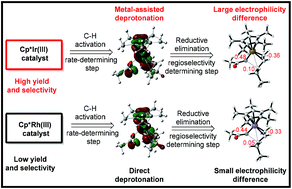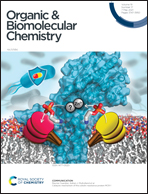Mechanistic studies of Cp*Ir(iii)/Cp*Rh(iii)-catalyzed branch-selective allylic C–H amidation: why is Cp*Ir(iii) superior to Cp*Rh(iii)?†
Abstract
Density functional theory calculations have revealed the mechanism and origins of the reactivity and regioselectivity of the Cp*Ir(III)/Cp*Rh(III)-catalyzed allylic C–H amidation of alkenes and dioxazolones. Generally, the catalytic cycle consists of alkene coordination, C(sp3)−H activation, dioxazolone oxidative addition, reductive elimination and proto-demetallation to give the final amidation product. The C–H activation is found to be the rate-determining step, and it controls the reactivity of the reaction. For the Cp*Ir(III)-catalyzed system, the C–H activation undergoes an Ir(III)-assisted proton transfer process with a low energy barrier, elucidating its high reactivity. In contrast, the C–H activation step is more like a direct deprotonation in the Cp*Rh(III)-catalyzed system, which is responsible for its higher barrier and lower reactivity. The branched-selectivity arises from the electronic effect of the alkyl group on the charge distribution over the allylic moiety. Herein, iridium(V) polarizes the allylic group greater than that of the rhodium(V) system, which accounts for its good regioselectivity. The mechanistic insights will be useful for the further development of transition metal-catalyzed selective C–H amination reactions.

- This article is part of the themed collection: Mechanistic, computational & physical organic chemistry in OBC


 Please wait while we load your content...
Please wait while we load your content...